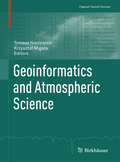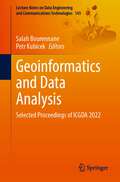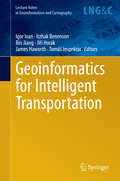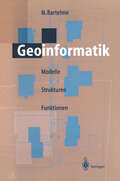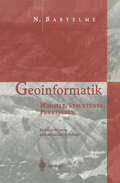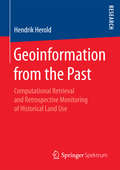- Table View
- List View
GeoHumanities: Art, History, Text at the Edge of Place
by Michael Dear Jim Ketchum Sarah Luria Douglas RichardsonIn the past decade, there has been a convergence of transdisciplinary thought characterized by geography’s engagement with the humanities, and the humanities’ integration of place and the tools of geography into its studies. GeoHumanities maps this emerging intellectual terrain with thirty cutting edge contributions from internationally renowned scholars, architects, artists, activists, and scientists. This book explores the humanities’ rapidly expanding engagement with geography, and the multi-methodological inquiries that analyze the meanings of place, and then reconstructs those meanings to provoke new knowledge as well as the possibility of altered political practices. It is no coincidence that the geohumanities are forcefully emerging at a time of immense intellectual and social change. This book focuses on a range of topics to address urgent contemporary imperatives, such as the link between creativity and place; altered practices of spatial literacy; the increasing complexity of visual representation in art, culture, and science and the ubiquitous presence of geospatial technologies in the Information Age. GeoHumanties is essential reading for students wishing to understand the intellectual trends and forces driving scholarship and research at the intersections of geography and the humanities disciplines. These trends hold far-reaching implications for future work in these disciplines, and for understanding the changes gripping our societies and our globalizing world.
Geoid Determination: Theory and Methods (Lecture Notes in Earth System Sciences)
by Fernando Sansò and Michael G. SiderisThis book will be based on the material of the lecture noties in several International Schools for the Determination and Use of the Geoid, organized by the International Geoid Serivice of the International Association of Geodesy. It consolidates, unifies, and streamlines this material in a unique way not covereed by the few other books that exist on this subjext. More specifically, the book presents (for the first time in a single volume) the theory and methodology of the most common technique used for precise determination of the geoid, including the computation of the marine geoid from satellite altimetry data. These are illustrated by specific examples and actual computations of local geoids. In addition, the book provides the fundamentals of estimating orthometric heights without spirit levelling, by properly combining a geoid with heights from GPS. Besides the geodectic and geophysical uses, this last application has made geoid computation methods very popular in recent years because the entire GPS and GIS user communities are interested in estimating geoid undulations in order to convert GPS heights to physically meaningful orthometric heights (elevations above mean sea level). The overall purpose of the book is, therefore, to provide the user community (academics, graduate students, geophysicists, engineers, oceanographers, GIS and GPS users, researchers) with a self-contained textbook, which will supply them with the complete roadmap of estimating geoid undulations, from the theoretical definitions and formulas to the available numerical methods and their implementation and the test in practice.
Geoinformatics and Atmospheric Science (Pageoph Topical Volumes)
by Tomasz Niedzielski Krzysztof MigałaThis volume presents recent developments in atmospheric sciences driven by numerical modeling which makes use of geospatial technologies and increasing computational power. It gathers examples of how geoinformatics supports meteorological, climatological and water-related studies. One of the most important features of geospatial technologies is that they provide methods and tools which may be utilized in real time or near real time in order to monitor and predict atmospheric processes. This is particularly crucial in areas where dynamics of atmospheric phenomena is considerable and causes difficulties in accurate forecasting. One of such areas is the transitional zone between oceanic and continental features of the mid-latitude climate. Good examples of investigations into the transitional zone come from Poland and its neighboring countries. The topical volume provides the reader with a selection of papers on physically-based and data-based modelling of weather-related phenomena over Poland. This main theme of the topical volume is extended to cover case studies on the use of geoinformatics in atmospheric studies in other regions at a range of spatial scales.
Geoinformatics and Data Analysis: Selected Proceedings of ICGDA 2022 (Lecture Notes on Data Engineering and Communications Technologies #143)
by Salah Bourennane Petr KubicekThis book contains the proceedings of the 5th International Conference on Geoinformatics and Data Analysis (ICGDA 2022), held in January 21–23, Paris, France. Geoinformatics helps to support basic scientific inquiry as well as address the complex social and environmental challenges. It becomes very important technology to decision-makers across a wide range of disciplines such as computer science, information technology, software engineering, biogeography, geography, conservation, architecture, spatial analysis and reinforcement learning. The papers included in this proceeding share the latest research results and practical application examples on the methodologies and algorithms in the area of geoinformatics and data analysis, including software and information engineering, environmental geography and geographic information system, which makes the book a valuable reference for researchers, engineers and university students who are working in the field.
Geoinformatics and Modelling of Landslide Susceptibility and Risk: An RS & GIS-based Model Building Approach in the Eastern Himalaya (Environmental Science and Engineering)
by Sujit Mandal Subrata MondalThis book discusses various statistical models and their implications for developing landslide susceptibility and risk zonation maps. It also presents a range of statistical techniques, i.e. bivariate and multivariate statistical models and machine learning models, as well as multi-criteria evaluation, pseudo-quantitative and probabilistic approaches. As such, it provides methods and techniques for RS & GIS-based models in spatial distribution for all those engaged in the preparation and development of projects, research, training courses and postgraduate studies. Further, the book offers a valuable resource for students using RS & GIS techniques in their studies.
A Geoinformatics Approach to Water Erosion: Soil Loss and Beyond
by Tal SvorayDegradation of agricultural catchments due to water erosion is a major environmental threat at the global scale, with long-lasting destructive consequences valued at tens of billions of dollars per annum. Eroded soils lead to reduced crop yields and deprived agroecosystem’s functioning through, for example, decreased water holding capacity, poor aeration, scarce microbial activity, and loose soil structure. This can result in reduced carbon sequestration, limited nutrient cycling, contamination of water bodies due to eutrophication, low protection from floods and poor attention restoration—consequences that go far beyond the commonly modelled soil loss and deposition budgets. This book demonstrates, using data from the Harod catchment in northern Israel, how cutting-edge geoinformatics, data science methodologies and soil health indicators can be used to measure, predict, and regulate these major environmental hazards. It shows how these approaches are used to quantify—in time and space—the effect of water erosion not only on the soil layer, soil minerals, and soil loss, but also on the wide-range of services that agricultural ecosystems might supply for the benefit and well-being of humans. The algorithms described in this book play a major role in this paradigm shift and they include, for example, extraction of photogrammetric DEMs from drone's data, advanced drainage structure calculations, fuzzy process-based modelling and spatial topographic threshold computations, multicriteria analyses and expert-based systems development using analytic hierarchal processes, innovative data-mining and machine learning tools, autocorrelation and interpolation of soil health, physically-based soil evolution models, spatial decision support systems and many more.
Geoinformatics for Intelligent Transportation (Lecture Notes in Geoinformation and Cartography)
by Igor Ivan Itzhak Benenson Bin Jiang Jiří Horák James Haworth Tomáš InspektorThe aim of the book is to present and discuss new methods, issues and challenges involved in geoinformatics’ contribution to making transportation more intelligent, efficient and human-friendly. It covers a wide range of topics related to transportation and geoinformatics. The themes are divided into four main sections: Transport modeling, Sensor data and services, Intelligent transport systems, and Transport planning and accessibility.
Geoinformatics for Spatial-Infrastructure Development in Earth and Allied Sciences: Proceedings of GIS-IDEAS 2023 (Lecture Notes in Civil Engineering #411)
by Dieu Tien Bui Anh Huy Hoang Thi Trinh Le Danh Tuyen Vu Venkatesh RaghavanThis volume gathers the latest advances, innovations, and applications in the field of GIS and geo-spatial technologies, as presented by leading researchers and engineers at the International Conference on Geoinformatics for Spatial-Infrastructure Development in Earth & Allied Sciences (GIS-IDEA), held in Hanoi, Vietnam on November 7-9 2023. The contributions cover a diverse range of topics, including geoinformatics, geomatics, geospatial AI for natural hazards, Big Data and AI in sustainable natural resource management, GIS and remote sensing for natural disaster monitoring, GIS for spatial analysis, planning and management, GeoAI for building digital maps. Selected by means of a rigorous peer-review process, they will spur novel research directions and foster future multidisciplinary collaborations.
Geoinformatics for Sustainable Development in Asian Cities (Springer Geography)
by Sathaporn Monprapussorn Zhaohui Lin Asamaporn Sitthi Parichat WetchayontThis proceedings volume focuses on the importance and power of spatial thinking and planning, especially by applying geospatial technologies in solving the past and current global problems such as environmental degradation, urban pollution, climate change, agricultural management and epidemiology.The proceedings of the International Conference on Geography and Geoinformatics for Sustainable Development 2018 (ICGGS 2018) consist of a wide range of case studies from developing countries. The contributions address challenges of developing countries in mainstreaming sustainable development paradigm into their economy with the aim to improve and manage natural resources and environment in a sustainable manner. One of the main goals of the conference and the proceedings is to share and exchange different perspectives on global, regional and local spatial issues and how the concept of spatial planning and thinking can be used in building resilience to natural and anthropogenic threats in many sectors (such as water, ecosystem, agriculture and health). This includes a summary of how the key concepts of geospatial technologies could contribute to environmental sustainability and the Sustainable Development Goals (SDGs) as well as an outlook on challenges and opportunities for sustainable development. This book explains how geoinformatics can help analyse, model and explain sustainable development within a geographic context and thus provide the integrative framework necessary for global collaboration consensus and evidence-based decision-making. It highlights the vital and integrative role of geospatial information in driving sustainable development and thus can be used as a tool to put the 2030 Agenda for Sustainable Development into practice. This volume can be a useful resource for readers regarding research on geospatial issues on both the regional and local scale. Both undergraduate and graduate students around the globe can advance their academic and research knowledge of past and present environmental problems and learn how geospatial planning can be applied for sustainable development. It also appeals to researchers, academics, practitioners, community developers and policy makers interested in promoting sustainable development.
Geoinformatics in Health Facility Analysis
by Praveen Kumar Rai Mahendra Singh NathawatThis book demonstrates how GIS techniques and statistical methods can be used to emphasise the characteristics of population and its related variables, vis-à-vis care facilities and the status of vector borne diseases, as well as for malaria modeling. Concentrating on the Varanasi district of India, the main aim of the book is to determine and map the density areas of vector borne diseases using GIS techniques.The book explores how health GIS is an important sub-discipline of health science and medical geography, which is traditionally focused on the spatial aspects of disease ecology and health care facility analysis.
Geoinformatics in Theory and Practice: An Integrated Approach to Geoinformation Systems, Remote Sensing and Digital Image Processing (Springer Textbooks in Earth Sciences, Geography and Environment)
by Norbert de LangeThis textbook is intended to display a broad, methodological introduction to geoinformatics and geoinformation science. It deals with the recording, modeling, processing and analysis as well as presenting and distributing of geodata. As an integrated approach it is dedicated to the multidisciplinary application of methods and concepts of computer science to solve spatial tasks. First the reader receives an introduction to the approach and tasks of geoinformatics, basic concepts and general principles of information processing as well as essentials of computer science. Then this textbook focuses on the following topics: spatial reference systems, digital spatial data, interoperability of spatial data, visualization of spatial information, data organization and database systems, geoinformation systems, remote sensing and digital image processing.The result is a comprehensive manual for studies and practical applications in geoinformatics. It serves also as a basis to support and deepen methodological courses in geography, geology, geodesy and surveying as well as all environmental sciences. In this first English edition, the author has updated and significantly expanded the fourth German edition. New additions include the development of apps, graphical presentation on the web, geodata-bases and recent methods of classification. This book is based on the original German 4th edition Geoinformatik in Theorie und Praxis by Norbert de Lange, published by Springer-Verlag GmbH Germany, part of Springer Nature in 2020 and still presents the only integrated perspective on geoinformatics and geoinformation science. This book was translated with the help of artificial intelligence (machine translation by the service DeepL.com) first and then significantly revised with regard to technical terms and special topics of geoinformatics.
Geoinformatik: Modelle, Strukturen, Funktionen
by Norbert BartelmeAls Fortführung und Erweiterung des 1989 erschienenen Buches "GIS-Technologie" beleuchtet dieses Werk die Grundlagen der Modellierung von Geoinformation in Datenbanken und informationsverarbeitenden Systemen. Damit spricht es einen breiten Personenkreis aus der Geographie, dem Vermessungswesen, den angewandten Geowissenschaften und auch aus den Informationswissenschaften an, der sich ein Bild vom aktuellen Wissensstand der Geoinformatik machen will. Der Bogen der behandelten Themen spannt sich vom Modellieren von Geo-Objekten im Raum bis zu ihrer Schematisierung in Datenbanken vor dem Hintergrund typischer GIS-Applikationen.
Geoinformatik: Modelle, Strukturen, Funktionen
by Norbert BartelmeOb im Alltag oder bei Fachfragen - wir begründen Entscheidungen nicht nur inhaltlich, sondern auch nach dem räumlichen und zeitlichen Zusammenhang. Die Geoinformation bietet Antwort auf beide Fragen. 'Geoinformatik' vermittelt einen breiten Überblick über die Modellierung von Geoinformation in Datenbanken und informationsverarbeitenden Systemen. Das Spektrum reicht von der Modellierung von Geo-Objekten im Raum bis zu ihrer Schematisierung in Datenbanken vor dem Hintergrund typischer GIS-Applikationen. Das Buch ist eine grundlegende Einführung für Praktiker, die sich umfassend über die wesentlichen Merkmale, aktuellen Anwendungsmöglichkeiten und Trends informieren möchten. Gleichzeitig liefert es Studierenden und Dozenten begleitendes Lehrmaterial für GIS-Veranstaltungen. Gegenüber den bisherigen Auflagen wurde die Struktur des Buches beibehalten, während die Inhalte an aktuelle Herausforderungen angepasst wurden. So durchzieht die Einbindung von Geoinformation bei Diensten, die auch in mobilen Umgebungen die geeignete Antwort auf raum-, zeit- und situationsbezogene Fragen geben, alle Kapitel dieser Neuauflage.
Geoinformatik: Modelle · Strukturen · Funktionen
by Norbert Bartelme'Geoinformatik' erläutert die Grundlagen der Modellierung von Geoinformation in Datenbanken und informationsverarbeitenden Systemen. Damit spricht es einen breiten Personenkreis aus der Geographie, dem Vermessungswesen, den angewandten Geowissenschaften und auch aus den Informationswissenschaften an, der sich ein Bild vom aktuellen Wissensstand und den Anwendungsmöglichkeiten der Geoinformatik machen will. Das Spektrum reicht dabei von der Modellierung von Geoobjekten im Raum bis zu ihrer Schematisierung in Datenbanken vor dem Hintergrund typischer GIS-Applikationen.
Geoinformatik: in Theorie und Praxis
by Norbert de LangeDas Buch versteht sich als breit angelegte, methodische Einführung in die Geoinformatik. Behandelt werden zehn zentrale Gebiete:- Ansatz und Aufgaben von Geoinformatik und Informatik- Grundbegriffe und allgemeine Grundlagen der Informationsverarbeitung - Grundlagen aus der Informatik - räumliche Objekte und Bezugssysteme - digitale räumliche Daten: Datengewinnung, Geobasisdaten und VGI- Standards und Interoperabilität von Geodaten- Visualisierung raumbezogener Informationen - Datenorganisation und Datenbanksysteme - Geoinformationssysteme- Fernerkundung und Digitale Bildverarbeitung.Entstanden ist ein umfassendes Handbuch für Studium und Praxis, das die Inhalte der Geoinformatik anwendungsbezogen zusammenführt und das darüber hinaus vielfältige Hintergrundinformationen liefert. Norbert de Lange hat die vorliegende dritte Auflage aktualisiert und wesentlich erweitert. Neu hinzugekommen ist ein Kapitel, das sich mit Standards zur Modellierung von Geodaten, mit Webservices und mit dem Aufbau von Geodateninfrastrukturen beschäftigt.Dieses Buch präsentiert noch immer die einzige integrierte Darstellung der Geoinformatik in deutscher Sprache.
Geoinformatik: in Theorie und Praxis
by Norbert de LangeDas Buch versteht sich als breit angelegte, methodische Einführung für Praktiker und Studenten. Die Ausarbeitung stellt ein breites Grundlagenwerk dar, das vielfältige Aspekte der Geoinformatik erläutert. Dabei stehen nicht Geoinformationssysteme im Vordergrund (das Werk hat ein Kapitel GIS), vielmehr werden auch Grundlagen der Kartographie und Vermessung aufgezeigt. Hierbei wird eine Auswahl getroffen. So werden nicht sämtliche Kartenprojektionen erläutert, aber Prinzipien verdeutlicht, soweit sie im Rahmen der Geoinformatik wichtig sind. Hierdurch sollen Grundlagen für das Arbeiten mit Koordinaten gelegt werden. In ähnlicher Weise werden die übrigen Inhalte behandelt. In der zweiten Auflage wurden alle Inhalte erweitert.
Geoinformatik: in Theorie und Praxis
by Norbert de LangeDas Buch versteht sich als breit angelegte, methodische Einführung für Praktiker und Studenten. Die Ausarbeitung stellt ein breites Grundlagenwerk dar, das vielfältige Aspekte der Geoinformatik erläutert. Dabei stehen nicht Geoinformationssysteme im Vordergrund (das Werk hat ein Kapitel GIS), vielmehr werden auch Grundlagen der Kartographie und Vermessung aufgezeigt. Hierbei wird eine Auswahl getroffen. So werden nicht sämtliche Kartenprojektionen erläutert, aber Prinzipien verdeutlicht, soweit sie im Rahmen der Geoinformatik wichtig sind. Hierdurch sollen Grundlagen für das Arbeiten mit Koordinaten gelegt werden. In ähnlicher Weise werden die übrigen Inhalte behandelt. In der zweiten Auflage wurden alle Inhalte erweitert.
Geoinformatik: Handbuch der Geodäsie, herausgegeben von Willi Freeden und Reiner Rummel (Springer Reference Naturwissenschaften)
by Monika SesterDas sechsbändige Handbuch ist ein hochwertiges Werk über die Geodäsie unserer Zeit. Neben einer guten Lesbarkeit vermittelt es dennoch den wissenschaftlichen Ansatz und richtet sich an Kollegen in Praxis und Wissenschaft, aus Nachbardisziplinen und allgemein an Studierende und Interessierte. Die in den Beiträgen behandelten Themen führen systematisch in Aufgabenstellung, Methodik und zukünftige Entwicklungen ein. Die Themen reichen von der Mathematischen und Physikalischen Geodäsie sowie der Satellitengeodäsie über die Ingenieurgeodäsie, die Bodenordnung und das Landmanagement, die Photogrammetrie und Fernerkundung bis zu Geoinformationssystemen und der Kartographie.
Geoinformatik in Theorie und Praxis: Grundlagen von Geoinformationssystemen, Fernerkundung und digitaler Bildverarbeitung
by Norbert de LangeDie Geoinformatik widmet sich der Entwicklung und Anwendung von Methoden und Konzepten der Informatik zur Lösung raumbezogener Fragestellungen unter besonderer Berücksichtigung des räumlichen Bezugs von Informationen. Sie beschäftigt sich mit der Erhebung oder Beschaffung, mit der Modellierung, mit der Aufbereitung und vor allem mit der Analyse sowie mit der Präsentation und der Verbreitung von Geodaten. Das Werk versteht sich als breit angelegte, methodische Einführung in die Geoinformatik. Behandelt werden zehn zentrale Gebiete: - Ansatz und Aufgaben der Geoinformatik - Grundbegriffe und allgemeine Grundlagen der Informationsverarbeitung - Grundlagen aus der Informatik - räumliche Objekte und Bezugssysteme - digitale räumliche Daten: Datengewinnung, Geobasisdaten und VGI - Standards und Interoperabilität von Geodaten - Visualisierung raumbezogener Informationen - Datenorganisation und Datenbanksysteme - Geoinformationssysteme - Fernerkundung und Digitale Bildverarbeitung. Entstanden ist ein umfassendes Handbuch für Studium und Praxis, das die Inhalte der Geoinformatik anwendungsbezogen zusammenführt und das darüber hinaus vielfältige Hintergrundinformationen liefert. Norbert de Lange hat die vorliegende vierte Auflage aktualisiert und wesentlich erweitert. Neu hinzugekommen sind Inhalte u.a. zur Entwicklung von Apps, zu graphischen Präsentationen im Web, zu Geodatenbanken und zu modernen Klassifikationsverfahren. Viele Beispiele wurden ergänzt, die aus Seminarveranstaltungen stammen und die sich zur Verdeutlichung der Methoden bewährten haben. Dieses Buch präsentiert noch immer die einzige integrierte Darstellung der Geoinformatik in deutscher Sprache.
Geoinformation: Remote Sensing, Photogrammetry and Geographic Information Systems, Second Edition
by Gottfried KonecnyWritten by a renowned expert, Geoinformation: Remote Sensing, Photogrammetry and Geographic Information Systems, Second Edition gives you an overarching view of how remote sensing, photogrammetry, and geographic information systems work together in an interdisciplinary manner. The book presents the required basic background of the geoinformatics co
Geoinformation for Informed Decisions (Lecture Notes in Geoinformation and Cartography)
by Alias Abdul Rahman Pawel Boguslawski François Anton Mohamad Nor Said Kamaludin Mohd OmarThis book presents the latest research developments in geoinformation science, which includes all the sub-disciplines of the field, such as: geomatic engineering, GIS, remote sensing, digital photogrammetry, digital cartography, etc.
Geoinformation from the Past: Computational Retrieval and Retrospective Monitoring of Historical Land Use
by Hendrik HeroldHendrik Herold explores potentials and hindrances of using retrospective geoinformation for monitoring, communicating, modeling, and eventually understanding the complex and gradually evolving processes of land cover and land use change. Based on a comprehensive review of literature, available data sets, and suggested algorithms, the author proposes approaches for the two major challenges: To address the diversity of geographical entity representations over space and time, image segmentation is considered a global non-linear optimization problem, which is solved by applying a metaheuristic algorithm. To address the uncertainty inherent to both the data source itself as well as its utilization for change detection, a probabilistic model is developed. Experimental results demonstrate the capabilities of the methodology, e.g., for geospatial data science and earth system modeling.
Geoinformation Metadata in INSPIRE and SDI: Understanding. Editing. Publishing (Lecture Notes in Geoinformation and Cartography)
by Leszek Litwin Maciej RossaThe book is a new comprehensive textbook about creating and publishing geoinformation metadata. It is a compendium of knowledge about geoinformation metadata in INSPIRE Directive and Spatial Information Infrastructures. It contains the knowledge necessary to understand prior to the creation of geoinformation metadata. Metadata – “data about data” - describe the layers of spatial data (data series, services) responding to the questions: what?, why?, when?, who?, how? and where? Geoinformation metadata allows for exact search of the spatial data according to given criteria, regardless of where this data is located. On 15 May 2007 the EU Directive 2007/2/EC came into force establishing Infrastructure for Spatial Information in Europe - INSPIRE. The proper functioning of the infrastructure for spatial information would not be possible without the metadata.
Geokinematics: Prelude to Geodynamics
by Rex H. PilgerThis multifaceted study explores new directions for plate tectonic research, especially as a guide for future geodynamic modelling of the earth. In particular, it equips readers with a plate-tectonic toolbox (with derivations and ANSI-C code) for applications and reconstruction analysis, including new continuous calculation methods. Pilger's Geokinematics shows how to apply these tools to Late Mesozoic and Cenozoic kinematics, with a focus on hotspot reference frames, and for empirical analysis of continental stress histories, including fractured hydrocarbon reservoirs. Supported by solid arguments and data, the book integrates theoretical developments of expanded plate kinematic theory and an ensemble of critical observations into a grand model, with the new concept of mesoplates playing a key role.
Geologic and Mine Modelling Using Techbase and Lynx
by Martin SmithThis text provides a process oriented discussion of the theory, methodology and philosophy of geologic and mine modelling using two commercial software packages: Techbase, a leader for mineral exploration and modelling bedded deposits; and Lynx, for modelling geology.


